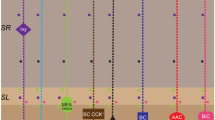Summary
Actions of dihydrokainate (DHKA) and 3-hydroxy-DL-aspartate (HAsp), inhibitors of high-affinity uptake for L-glutamate (Glu), were studied in vitro in thin hippocampal slices of the guinea pig. The amplitude of the depolarizations induced by Glu and by L-aspartate (Asp) in CA3 neurons are markedly augmented by DHKA and HAsp. Depolarizations induced by D-homocysteate (DH) were unaffected by the inhibitors. In about half of the neurons, depolarizations induced by L-homocysteate (LH) and by quisqualate (Quis) were slightly augmented by the inhibitors. Fast responses to kainate (KA) were augmented by the inhibitors to a similar extent as were Glu responses whereas slow KA responses were insensitive to HAsp. HAsp was without effect on excitatory postsynaptic potentials elicited by stimulation of granular layer. These findings are in general agreement with the biochemical data on amino acid uptake processes and are also consistent with the slow time-courses of depolarizations induced by DH, LH and Quis. Augmentation of fast KA responses provides strong evidence for the hypothesis that an KA pulse causes a liberation of Glu and/or Asp from the tissue and the liberated amino acid(s) induces the fast KA response in neurons nearby.
Similar content being viewed by others
References
Balcar VJ, Johnston GAR (1972) The structural specificity of high affinity uptake of L-glutamate and L-aspartate by rat brain slices. J Neurochem 19: 2657–2666
Balcar VJ, Johnston GAR, Twitchin B (1977) Stereospecificity of the inhibition of L-glutamate and L-aspartate high affinity uptake in rat brain slices by threo-3-hydroxyaspartate. J Neurochem 28: 1145–1146
Cox DWG, Headley MH, Watkins JC (1977a) Actions of L-and D-homocysteate in rat CNS: a correlation between low-affinity uptake and the time courses of excitation by microelectrophoretically applied L-glutamate analogues. J Neurochem 29: 579–588
Cox DWG, Osborne RH, Watkins JC (1977b) Actions of L-glutamate and related amino acids on oxygen uptake, lactate production and NADH levels of rat brain in vitro. J Neurochem 29: 1127–1130
Crawford IL, Connor JD (1973) Localization and release of glutamic acid in relation to the hippocampal mossy fibre pathway. Nature (Lond) 244: 442–443
Curtis DR, Johnston GAR (1974) Amino acid transmitters in the mammalian central nervous system. Ergeb Physiol 69: 97–188
Eccles JC (1964) The physiology of synapses, Academic Press, New York
Fagg GE, Foster AC (1983) Amino acid neurotransmitters and their pathways in the mammalian central nervous system. Neuroscience 9: 701–719
Johnston GAR, Curtis DR, Davies J, McCulloch RM (1978) Spinal interneurone excitation by conformationally restricted analogues of L-glutamic acid. Nature (Lond) 248: 804
Johnston GAR, Kennedy SME, Twitchin B (1979) Action of the neurotoxin kainic acid on high affinity uptake of L-glutamic acid in rat brain slices. J Neurochem 32: 121–127
Johnston GAR, Lodge D, Bornstein JC, Curtis DR (1980) Potentiation of L-glutamate and L-aspartate excitation of cat spinal neurones by the stereoisomers of threo-3-hydroxyas-partate. J Neurochem 34: 241–243
Krnjevic K (1974) Chemical nature of synaptic transmission in vertebrates. Physiol Rev 54: 418–540
Lodge D, Curtis DR, Johnston GAR, Bornstein JC (1980) In vivo inactivation of quisqualate: studies in the cat spinal cord. Brain Res 182: 491–495
Lodge D, Johnston GAR, Curtis DR, Bornstein JC (1979) Kainate neurotoxicity and glutamate inactivation. Neurosci Lett 14: 343–348
Logan WJ, Snyder SH (1972) High affinity uptake systems for glycine, glutamic and aspartic acids in synaptosomes of rat central nervous tissues. Brain Res 42: 413–431
Sawada S, Takada S, Yamamoto C (1983) Selective activation of synapses near the tip of drug-ejecting microelectrode, and effects of antagonists of excitatory amino acids in the hippocampus. Brain Res 267: 156–160
Sawada S, Yamamoto C (1984) Fast and slow depolarizing potentials induced by short pulses of kainic acid in hippocampal neurons. Brain Res 324: 279–287
Storm-Mathisen J, Leknes AK, Bore AT, Vaaland JL, Edminson P, Haug FM, Ottersen OP (1983) First visualization of glutamate and GABA in neurones by immunocytochemistry. Nature (Lond) 301: 517–520
Takagaki G (1976) Properties of the uptake and release of glutamic acid by synaptosomes from rat cerebral cortex. J Neurochem 27: 1417–1425
Yamamoto C (1972) Activation of hippocampal neurons by mossy fiber stimulation in thin brain sections in vitro. Exp Brain Res 14: 423–435
Yamamoto C, Sawada S (1982) Sensitivity of hippocampal neurons to glutamic acid and its analogues. Brain Res 235: 358–362
Author information
Authors and Affiliations
Rights and permissions
About this article
Cite this article
Sawada, S., Higashima, M. & Yamamoto, C. Inhibitors of high-affinity uptake augment depolarizations of hippocampal neurons induced by glutamate, kainate and related compounds. Exp Brain Res 60, 323–329 (1985). https://doi.org/10.1007/BF00235927
Received:
Accepted:
Issue Date:
DOI: https://doi.org/10.1007/BF00235927




